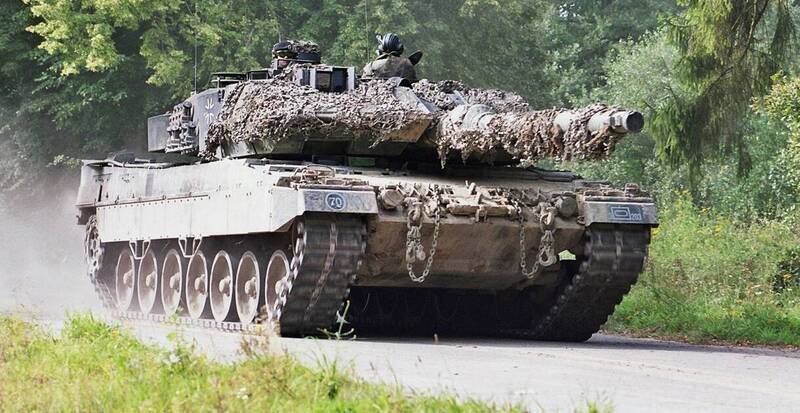German "Leopard-2A6" main tank.
(Taken from the official website of KMW, Germany)
[Central News Agency] Russia's invasion of Ukraine is about to expire for a year, and the battle is in a stalemate. Whether Ukraine can obtain enough ammunition to support the deployment of Western tanks on the front line has become the key for the Ukrainian army to turn the tide of the war and regain lost ground.
The first is the problem of ammunition shortage.
Since the end of World War II, the ammunition consumption rate of the largest war in Europe is astonishing. According to NATO estimates, Ukraine fires 5,000 to 6,000 shells every day, and the Russian army has as many as 20,000. .
Please read on...
Ammunition inventory is a national defense secret. NATO's goal is to be able to cope with at least 30 days of war, but most countries do not meet the standard.
According to the research of the British think tank "Royal United Military Institute" (RUSI), the stockpile of the British army is only enough to fight a war for a week, and many countries can only fight for a day. Only the United States and Finland, which applied to join NATO last year, have enough stocks to fight a long-term war .
Europe has been at peace for a long time, and it feels that it is not directly threatened. The output of artillery shells has declined year by year, and it has fallen into the dilemma of insufficient supplies. On the other hand, Russia not only has a large inventory left over from the Soviet era, but also has overtime production in the arms industry. It is difficult for the Ukrainian army to win by quantity. Parry.
North Atlantic Treaty Organization (NATO) Secretary-General Jens Stoltenberg (Jens Stoltenberg) said at a meeting of defense ministers that Ukraine is consuming ammunition at several times the rate of the production line, straining the arms industries of allied countries. A "race to logistical supplies."
Western countries have clearly recognized the importance of ammunition production.
Since Germany delivered the Gepard anti-aircraft artillery vehicle to Ukraine, it has been encountering the problem of Switzerland refusing to export ammunition on the grounds of neutrality. Recently, it simply entrusted the German arms dealer "Rheinmetall" (Rheinmetall) to produce 300,000 artillery shells. Assist the Ukrainian army against drones.
The European Union (EU) even considered copying the experience of purchasing COVID-19 vaccines in recent years and jointly purchasing ammunition from the arms industry.
Estonian Prime Minister Kaja Kallas said at the Munich Security Conference last week that Russia fires artillery shells equivalent to a month's production in Europe, not to mention the fact that the Russian arms industry works day and night in three shifts. "Ukraine cannot win without ammunition." .
In the past year since the war started, in the face of the Russian army's sea-of-people tactics and the rain of artillery shells, the Ukrainian army has shown high fighting spirit and resisted the invasion with flexible tactics and network technology. Many military experts bluntly said that the Ukrainian army, which has experienced many battles The military strength is already one of the best in Europe.
However, the Ukrainian Army mainly uses Soviet and Russian-made tanks. Only by deploying Western tanks with superior firepower and mobility to the front line can it break through the enemy's defense lines and regain lost ground.
At the beginning of this year, Britain took the lead in announcing that it would provide Ukraine with Challenger 2 tanks. The United States also agreed to provide Ukrainian M1 Abrams tanks. France also considered following up with military assistance for Leclerc tanks.
However, military experts agree that Germany has a large number of Leopard tanks, is relatively easy to supply and maintain, and has powerful performance. It is the most suitable main tank for the Ukrainian battlefield.
The Leopard is the most popular tank in Europe, with nearly 2,000 Leopard 2s owned by NATO allies.
Worried about the escalation of the war, Germany hesitated for more than half a year, and finally agreed to deliver 14 of the most advanced Leopard 2 tanks to Ukraine in January. It also asked for help from arms dealers, intending to help Ukraine with hundreds of tanks that served in the 1960s to 1980s. Leopard 1 (Leopard 1) tank.
Germany's goal is to establish two tank battalions for Ukraine, requiring a total of 62 Leopard 2 tanks.
Prime Minister Olaf Scholz promised to provide assistance in training, supplies, and logistics, and urged countries capable of delivering tanks to Ukraine to join Germany.
"Only by continuing to provide military assistance to Ukraine can the war end as soon as possible."
The top general of the German army, Bundeswehr Chief Eberhard Zorn, revealed that Ukrainian soldiers are being trained in Germany to learn how to operate this advanced tank, which could be on the battlefield as soon as next month.
